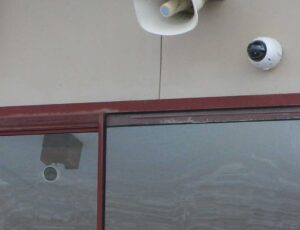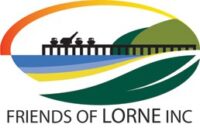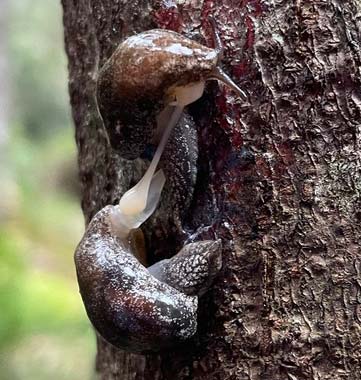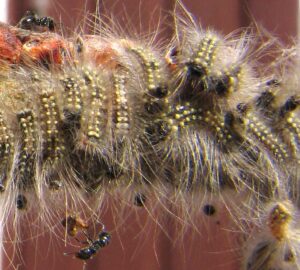Occasional newsletter, January 2023
A very happy New Year to all from the Committee of the Friends of Lorne
St John Sutton, Lindy Pearce, Mary Lush and Penny Hawe were re-elected to the Committee at our AGM. They have since been joined by Mary Rose Yuncken who has agreed to fill one of our vacancies. Welcome Mary Rose.
First FoL event for 2023
Tuesday 24th January, 11 AM. Introduction to iNaturalist
Venue: Lorne Community House
Native snails caught in a prelude to mating. Image: Mary Lush.
Mary notes that, thanks to iNaturalist, she now knows that these snails belong to an undescribed species that lives only in the Otways and on King Island.
What’s iNaturalist?
It’s an international community of people interested in nature. More prosaically, it provides a way of identifying the living (or once living) things that we see around us. It is used by experts, rank amateurs, and people in between. You don’t need to know what it is that you are looking at – iNaturalist will help you to sort that out. And it’s FREE.
Becoming a user is not especially difficult, but like most things it’s easier with an introduction. Hence the session.
Why become a contributor?
Publicity associated with the 2022 United Nations COP15 biodiversity summit produced all manner of alarming factlets, including that Australia is one of 17 ‘megadiverse’ nations in the world at the same time as being the ‘extinction capital’ of the world. Do we want to be both of these things? By using iNaturalist we can make tangible contributions to environmental knowledge of Lorne and the region. Observations sent to iNaturalist ultimately reach the Alas of Living Australia, a CSIRO database.
All living things, whether rare or common, including the rather unprepossessing snails featured above, warrant an entry on iNaturalist. If you use a laptop, pad or smartphone, bring it with you to the session.
A final note: space in the Community Centre is limited. If there is an overflow we will run a second session at 1 PM. Please let us know now (committee@friendsoflorne.org.au) if you can only come at 1 PM.
_____________________________
Other January dates to note
Wednesday 18th January, 11 AM Community Forum – Managing Bins and Cockatoos in Lorne http://surfcoast.vic.gov.au/binlock
Venue: Stribling Reserve Community Pavilion
Lorne is not alone in having a love/hate relationship with sulphur crested cockatoos. It’s possible to admire their beauty and cleverness, even as they throw rubbish around the nature strip.
John Martin (who is not a participant in the forum), suggests that their ability to open bins is a learned behaviour that is spreading from its origin in some extra smart cockatoos in southern Sydney. He would like to receive videos of cockatoos opening bins – but his definition of bin opening is quite a strict one. It doesn’t count if the lid is already partly open because the bin is overfull. If you have such video, please get in touch with him (Western Sydney University) or Friends of Lorne.
Sunday 22nd January. Entries close for the Christos Poetry Prize https://thechristospoetryprize.com/rules-of-entry/
_____________________________
What coastal vegetation is ‘right’ for Lorne?
What sorts of plants should be growing along Lorne’s foreshore? Should biodiversity and its preservation be the principal concern, or should unobstructed views of the sea be paramount? A couple of months ago GORA (Great Ocean Road coast and parks Authority) released its latest five year management plan for coastal vegetation. The new plan is more or less business as usual, which means that preservation and rehabilitation of natural vegetation is the dominant theme. This is a position that Friends of Lorne endorses. But opinions on foreshore vegetation always vary and emotions run high on the roles of grasses and coastal tea tree.
GORA manages the foreshore from Torquay to Marengo. Some areas are relatively pristine (if something can be relatively pristine), but areas within towns are highly modified. The 2022 Coastal Vegetation Strategy just released by GORA is based on its predecessor’s (the Great Ocean Road Coast Committee)) ‘Native Vegetation and Weed Action Plan’. In essence, natural vegetation is set as the benchmark to work towards. This means maintaining areas that are in a good state and restoring those that aren’t.
To what extent is the plan consistent with community values? There are lots of ‘communities’ to consider in addressing this question.
There is the ‘community’ of government, university and independent ecologists whose work has directly or indirectly been used to define the ‘natural’ state. For much of Lorne, the benchmark vegetation is deemed to be small and medium shrubs, plus herbs and grasses and occasional trees. GORA’s aim is to protect, or rehabilitate areas to, this state. There are exceptions, including areas that are very heavily used and ones in which the plantings form part of the history of Lorne.
Another community is the totality of people who use the Victorian coast. Surveys of these people always turn up the same findings. The natural beauty, beaches and wildlife are the things we value most. The legislated objective that GORA should ‘protect, conserve, rehabilitate and manage Crown lands and coastal assets’ therefore seems consistent with public opinion. It is also consistent with the statement of purpose of the Friends of Lorne. And, indeed, with the increasing and Australia-wide effort to protect biodiversity.
Among the community of people involved with Lorne, there are some who approve of the overall objectives of GORA, but have bones to pick on details. These bones are often to do with what is, or is not, a weed. A recent example is coastal tea tree (Leptospermum laevigatum) which GORA classes as a weed and is progressively removing from most areas. An argument made against removal is that these plants serve an ecological purpose and that their loss may fragment the remaining vegetation to the point of putting other living things at risk. Another argument is that foreshore vegetation, including coastal tea tree, provides privacy to beach users by screening them from the traffic of the Great Ocean Road. That screening function will be weakened as coastal tea tree is thinned in some parts of our foreshore but, provided that plants with a similar form take its place, the change will be a transient one.
And there is also the human attachment factor. As pointed out by Greg Moore in our October webinar, humans sometimes become very fond of particular plants. In recognition of this sort of human factor, GORA will retain some of Lorne’s most notable tea trees.
Moving on from weeds, other members of the community reject other elements of GORA’s plan for a vegetated foreshore. Their reasons include that plants are a fire hazard, that house users and people travelling the Great Ocean Road should have an open view of the sea, and that GORA has misidentified the natural state of the foreshore which should in fact be grassland. Some of these views are promoted by the recently formed Lorne Foreshore Conservation Group.
It seems unwise to be dogmatic about what vegetation is ‘right’ at any particular point or time along the coast, because the ‘natural’ state is variation. Variation from one metre to the next. Variation from one day to the next. Variation in the stage of ecological succession reached on the range of land forms present.
Most of Lorne’s foreshore is made up of a narrow strip of flat sand and seaward slopes that are not sand. Even were we to suppose that it is made up of a single land form, and that that land form is a system of sand dunes, ecological succession means we would not have one ‘right’ type of vegetation.
According to textbooks, succession on sand dunes goes more or less like this: by some circumstance a patch of sand stays still for long enough to be colonised by plants that can take root quickly, such as some grasses and herbs. The tops of these plants (and to a lesser extent the roots), stabilise that patch of sand. Sometimes their tops will trap more sand, more plants will take root, organic matter will enrich the sand resulting, with the passing of time, in a more stable, deeper and richer soil. Shrubs and even small trees will invade as soon as the rooting medium suits them.
But succession is not a one-way process. There will be many reversals, not just because of the action of the sea itself, but also because of erosion caused by water flowing to the sea. Some reversals will be locally severe enough to take us back to bare sand or rock – ‘square one’ or even ‘square minus one’. It follows that many assemblies of plants will be ‘natural’.
Where to from here? GORA plans to hold information sessions in early 2023. As background for such sessions Friends of Lorne is preparing an illustrated version of GORA’s plans for the various foreshore regions within Lorne. We will notify you when this work is ready.
_____________________________
Surf cams on the Surf Coast
 Image: Mary Lush
Image: Mary Lush
An increasing number of surf cams operate along the Surf Coast. Some of these cameras clearly identify individuals in the water, on the beach and in some cases, on walking tracks. The output from some is freely available on the web, and that from others is available to subscribers. Are they a benefit for the community or an invasion of privacy? Who decides? This article is an edited and updated version of material made available to the Great Ocean Road Communities Network, of which Friends of Lorne is a member.
Surf cams are digital cameras that stream video footage or still images of surf spots along the coast via the internet, continuously and in real time. In Lorne, output is streamed to the web from cameras on the Surf Life Saving Club (SLSC) to subscribers only, and from the Cumberland Resort to all web users.
Their use is subject to regulations but, as with other aspects of these relatively new technologies, it is not clear if the existing rules are being applied or are appropriate. The Privacy Act 1988 may apply. The Act contains a number of principles by which the information cameras collect and share is managed, including the following:
- Australian Privacy Principle 4: individuals must be unidentifiable
- Australian Privacy Principle 5: individuals need to be notified or made aware that they are identifiable in footage
Many in the community assumed the surf cams, some of which have been in place for 15 to 20 years, were operating in a manner that was consistent with the above requirements and with the necessary consents. Consent to ‘Use and Develop’ coastal Crown Land is required under the Marine and Coastal Act 2018 (part 65) and the Coastal Management Act 1995 (parts 37 & 38).
The Department of Environment Land Water and Planning (DELWP) state they do not have any agreements in place for any surf cam mounted on crown land in Victoria. This includes SLSC buildings which are on land leased to them by GORA (Great Ocean Road coast and parks Authority, also known as GORCAPA).
The Marine and Coastal Act 2018 is implemented by the Marine and Coastal Policy (MACP) 2020 which requires ;
- Policy 12.4 says ‘Support meaningful engagement with all affected parties in planning and decision making.’ Policies 12.1c and 12.13b also have provision for broad and diverse consultation.
- That cumulative impacts be considered. Policy 8.1f states ‘avoidance or minimisation of adverse impacts (direct, cumulative or synergistic) on ecosystems and habitats, local values, and landscape features.’ The MACP also says (p. 26), ‘…each decision may result in an increment of change that is individually insignificant but if repeated over time may accumulate and contribute to significant environmental change.’ Managing these effects means ‘…drawing the line before effects become unacceptable.’
- Uses to be sustainable. Policy 8.3a says, ‘minimise and seek to avoid negative impacts on ecosystems and habitats, local values and landscape features.’ Policy 14.23 says, ‘Planning and management must not only be responsive to present conditions and challenges but include future scenarios and possible new uses.’
- Community benefit. The MACP (p. 32) states ‘Crown land and waters are held in trust for the benefit of the Victorian community…’ Many surf cam operators are not Victorian entities.
Consent is required from GORA for these surf cams. GORA’s CCTV policy requires lease holders to:
- Demonstrate how CCTV footage will be used
- Demonstrate the benefit of CCTV usage including wider community benefit
- Show, where applicable, appropriate consultation with stakeholders has occurred
- Have a process in place to safeguard the privacy of individuals captured on CCTV footage
The policy considers negative impacts of CCTV to be (but not limited to):
- Commercial use in which footage is sold or given to a third party
- Indiscriminate live broadcasting without a specific time limited permit in place
GORA says they want to take a balanced approach. It advised that they had directed all leaseholders (the SLSCs and the Torquay Marine Rescue Service) that have surf cams installed to have them turned off, but the cameras remain operational.
The latest information from GORA, via an article in the Surf Coast Times on 11th August 2022, is that ‘…temporary permission has been granted to two SLSC clubs on the Surf Coast, Jan Juc and Lorne, to keep their CCTV cameras on after it was stated they were critical to maintaining public safety.’ Later in the article GORA states ‘All clubs are still required to make an application to operate the cameras where they must outline what processes are in place to safeguard the privacy of people likely to be captured on camera, consult with stakeholders about their use and demonstrate their benefit to the wider community.’
As of 31st December 2022, some surf cams that were not granted temporary permission remain in operation.
With GORA determining the future of all surf cams on land they manage it is probably best that communities have their say sooner rather than later. GORA says they will happily receive submissions from groups and community members, although they are not in a formal consultation process. Emails can be sent to info@GreatOceanRoadAuthority.vic.gov.au
_____________________________
Consultations/policies/activities 2023
On housing essential workers. What’s happening, what next?
Police, teachers, health workers, hospitality workers. These are people who are essential to Lorne’s functioning who find it tough to rent or buy homes here.
For the past few years some creative thinking has gone into accommodating seasonal workers, but it is a bit hit-and-miss. Better solutions may now be on the way as the result of work by the Committee for Lorne, especially Graham Brawn and the Lorne Business and Tourism Association. With the Committee for Lorne, Friends of Lorne are planning a webinar series on affordable housing for February 2023.
Speakers will address issues like rental incentives and making homes more affordable through various types of shared equity schemes. Joining us will be Louise Crabtree-Hayes from the University of Western Sydney. Louise is a researcher and expert on Community Lands Trusts (CLT). Also, we will have Andrew Paul who runs a CLT in a Queensland resort town that faces the same issues as Lorne. We’re partnering with the Surf Coast Shire Council to run the webinars, so we’ll also hear about local solutions and ideas too.
So why does it matter to you? Community support means a great deal. Lorne’s natural environment is a central value of Friends of Lorne, but the town must be viable and liveable as well. We will keep you informed about the series.
On nature strips
In 2022 the Surf Coast Shire Council released a draft policy for managing residential nature strips.
Nature strips are a key part of the neighbourhood character of Lorne. Increasingly, the Lorne tree canopy is being reduced to the trees in nature strips. Our response can be read here. The policy should be finalised in early 2023.
On water supply
In 2022 Barwon Water finalised its document ‘Water for our future’. We participated in this process by responding to the document when it was in draft form. Barwon Water will be undertaking some form of community consultation about the plans for Lorne during 2023.
A water saving modification made in 2022 involved changes to Lorne’s filtration system. Barwon Water advises that it has installed digital water meters in some areas on a trial basis. In addition to contributing to understanding of water use, digital water meters can save water by detecting leaks.
Making Friends of Lorne better known and stronger
We have recently published a short item in the Lorne Independent (January 2023) about our organisation entitled ‘Can you Imagine Lorne without the Swing Bridge?’ It explained how Lorne would have lost the Swing Bridge in the mid-1970s were it not for the activism of the Lorne Planning and Preservation League (we changed our name to Friends of Lorne in 2002).
You might think that all the best/worse of what could happen in Lorne is behind us. But you would be wrong. Right now, for example, there is nothing to stop chains such as McDonalds or Dunkin’ Donuts or KFC setting up in Lorne. Nothing in the planning scheme specifically protects the character of our ‘CBD’. A local heritage overlay does not automatically stop a much-loved building being levelled either. So there is always work to do to protect what is considered special and significant about Lorne.
The Committee is striving to make our activities better known, to build a wider membership, and to create more community engagement with planning and environment issues. All members are welcome to attend committee meetings if they wish. Let us know if you are interested and we will forward dates. For the last two years we have met by Zoom, but we expect to hold hybrid meetings in 2023 (i.e. face to face with some attendees online).
So, talk us up. Recruit your friends and family. Come and help.
_____________________________
Natural history note on insect palates
From Mary Lush
Caterpillars, scale insects and ants on a gum twig. Image: Mary Lush
In their normal lives these hairy caterpillars dine on almost everything a young gum leaf has to offer, leaving behind only a skeleton formed by uneaten leaf veins. Their eating habits give them their name of gum leaf skeletonisers, or more officially, Uraba lugens. These ones had a photo avoidance strategy that involved abseiling from the twig on a thread of silk, rather like a spider. Their use of silk is normal behaviour, but their presence on a twig is not. What are they doing?
Skeletonisers arrive in my part of Lorne every spring. In bad years (or good ones if you eat the caterpillars or moths), they completely defoliate small saplings. Last summer, mature trees in north Lorne were ravaged by another caterpillar, but in that case the culprits were cup moth larvae. Eucalypts seem to survive this sort of thing provided it isn’t too severe or doesn’t happen too often.
But if the caterpillars in the photograph are supposed to be skeletonising leaves, what are they doing on a twig? Ted Edwards, the entomologist to whom I am indebted for the identification, speculates that they have developed a taste for sugar. The pink blobs in the top right of the image are scale insects, and a waste product of scale insects is sugar, also called honey dew. Ants (also in the image) are enthusiastic harvesters of these sugars, but gum leaf skeletonisers are not known to be.
What is going on? To return to a suggestion at the start of this newsletter, I uploaded the image to iNaturalist. So far the only comment has been ‘interesting’, but I live in hope.



